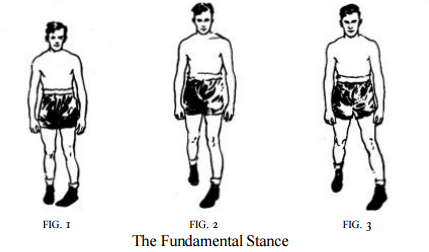PUNCHING WITH THE TOES: THE SECRETS OF HITTING HARD

Photo by Josh Hedges/Zuffa LLC
I am constantly recommending Edwin Haislet's masterpiece, On Boxing to readers who ask for further studying material. I love the text so much, in fact, that I am two articles in to a series examining its key ideas. Look up The Bible of Striking to read those.
But of all the people I have recommended this book to over the years, I would estimate that probably a third get back to me with the same bemused enquiry: “What's the deal with the stance?”
Despite seeming to be a sage in all aspects of the fistic game—from outfighting to infighting, and point fighting to power punching—Haislet advises a stance which is altogether alien to even many of those who have studied the boxing game at length. The traditional fighting stance we are all familiar is a case of “forward and forty-five”, with the lead foot pointing straight ahead and the back foot pointing slightly outwards, in a comfortable position. Haislet's recommended stance is a contorted reversal of that position.


This knock-kneed position is the one which Haislet prescribes as the best for mobility and hitting power, yet if you saw someone in this position without the gloves or shorts, you'd assume they had been in some kind of terrible accident. While I don't believe that such a perfect position exists in any single stance, I do feel that this seemingly archaic method has some important points to teach us about power generation.
Fighting to the Side
We've spoken before about stance, in fact it was the subject of the first episode of Jack Slack's Ringcraft:
View: https://www.youtube.com/watch?v=aDKJSROvgMA
LINK to full article here: Punching with the Toes: The Secrets of Hitting Hard | FIGHTLAND

Photo by Josh Hedges/Zuffa LLC
I am constantly recommending Edwin Haislet's masterpiece, On Boxing to readers who ask for further studying material. I love the text so much, in fact, that I am two articles in to a series examining its key ideas. Look up The Bible of Striking to read those.
But of all the people I have recommended this book to over the years, I would estimate that probably a third get back to me with the same bemused enquiry: “What's the deal with the stance?”
Despite seeming to be a sage in all aspects of the fistic game—from outfighting to infighting, and point fighting to power punching—Haislet advises a stance which is altogether alien to even many of those who have studied the boxing game at length. The traditional fighting stance we are all familiar is a case of “forward and forty-five”, with the lead foot pointing straight ahead and the back foot pointing slightly outwards, in a comfortable position. Haislet's recommended stance is a contorted reversal of that position.


This knock-kneed position is the one which Haislet prescribes as the best for mobility and hitting power, yet if you saw someone in this position without the gloves or shorts, you'd assume they had been in some kind of terrible accident. While I don't believe that such a perfect position exists in any single stance, I do feel that this seemingly archaic method has some important points to teach us about power generation.
Fighting to the Side
We've spoken before about stance, in fact it was the subject of the first episode of Jack Slack's Ringcraft:
View: https://www.youtube.com/watch?v=aDKJSROvgMA
LINK to full article here: Punching with the Toes: The Secrets of Hitting Hard | FIGHTLAND



